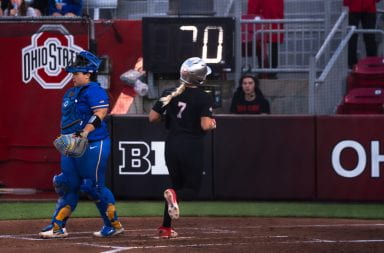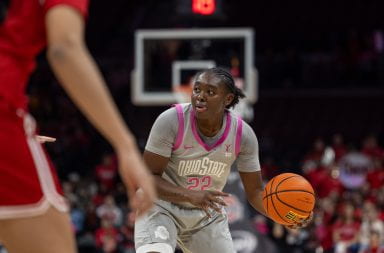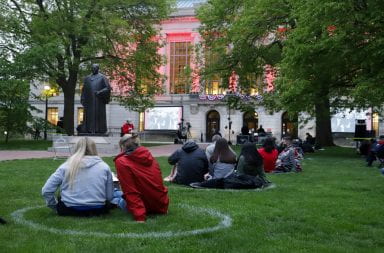Among a grassy sea with 147,000 headstones, mausoleums and burial markers at Green Lawn Cemetery, one headstone in Section 87 is particularly important to Ohio State’s history.
It is where Howard Dwight Smith, famed architect of Ohio Stadium, lies.
Green Lawn’s First Saturday program, which highlights noteworthy aspects of the cemetery, paid tribute to Smith on Saturday. His daughter, Myrna Dupler, shared stories about Smith with the 15 attendees.
“I was born at the same time the stadium was born,” said Dupler, 88. “We both arrived together on the earth … so I never forget when my birthday is.”
Ohio Stadium opened in 1922, and the American Institute of Architects awarded Smith a gold medal for his work on it.
Smith designed 57 buildings on OSU’s campus, Dupler said, including Hughes Hall, St. John Arena, French Field House and the first renovation of the William Oxley Thompson Library in 1951.
“He was a very square guy, and his students said he was a strict teacher,” Dupler said. “But my dad was a good problem-solver and creative at coming up with things that had never been done, like the horseshoe design.”
Smith never shared stories of his work at home with his family, but that didn’t bother Dupler, who lives in Upper Arlington.
“When you’re related to a famous person, you get asked crazy questions,” Dupler said. “People ask me if he told me about his work. I say, ‘Well, no. I was just a baby.'”
Dupler said her father was also the architect of Red Bird Stadium, now known as Cooper Stadium. There has been dispute about whether Smith used the same designs used for Red Wing Stadium, built in Rochester, N.Y., in 1929.
“Once, a reporter from The Dispatch tried to tell me that my dad copied another stadium in New York,” Dupler said. “It made me so angry. If I ever see that reporter again …”
Smith was born in Dayton and graduated from OSU in 1907. He then studied at Columbia University and in Europe.
After returning to Columbus in 1918, he became a professor of architecture at OSU and was the university architect from 1929 to 1956.
“You know OSU professors don’t make much money, but my dad was kind of a socialist and he was proud that he didn’t make much,” Dupler said. “But he was one of the few people who still had a job during the Depression.”
Smith passed away in April 1958 at the age of 72.
Robert Albrecht, 65, is a regular attendee of the First Saturday sessions, simply because he is “goofy about Columbus history,” he said. He asked Dupler what her father would think of the additions to the ‘Shoe.
“I think it would break his heart but I think he would realize it had to be done,” Dupler said.
Dupler also shared that her father would think the new Ohio Union is a bit too much.
“He was more on the simple side,” she said.
Nancy Heath is a long-time friend of Dupler’s and accompanied her to the event.
“This is stimulating for her,” said Heath, 86. “She likes talking about her father and she inherited her father’s intelligence.”
Linda Burkey, the general manager of Green Lawn, said the First Saturday programs have been a monthly occurrence for five years, with the intent of keeping history alive in Columbus.
Volunteers are constantly researching those buried at the 360-acre cemetery, Burkey said.
Green Lawn’s volunteer coordinator, Sandi Latimer, is one of the researchers and found Dupler through Upper Arlington’s Parks and Recreation Department.
Green Lawn is also home to five former Ohio governors, ancestors of four U.S. presidents, three Medal of Honor recipients and three former OSU presidents.
November’s First Saturday topic will be about the value of the trees at Green Lawn, and December’s topic will be about magician Howard Thurston’s family.
“There are 150,000 people buried here,” Latimer said. “That means 150,000 stories to share.”


